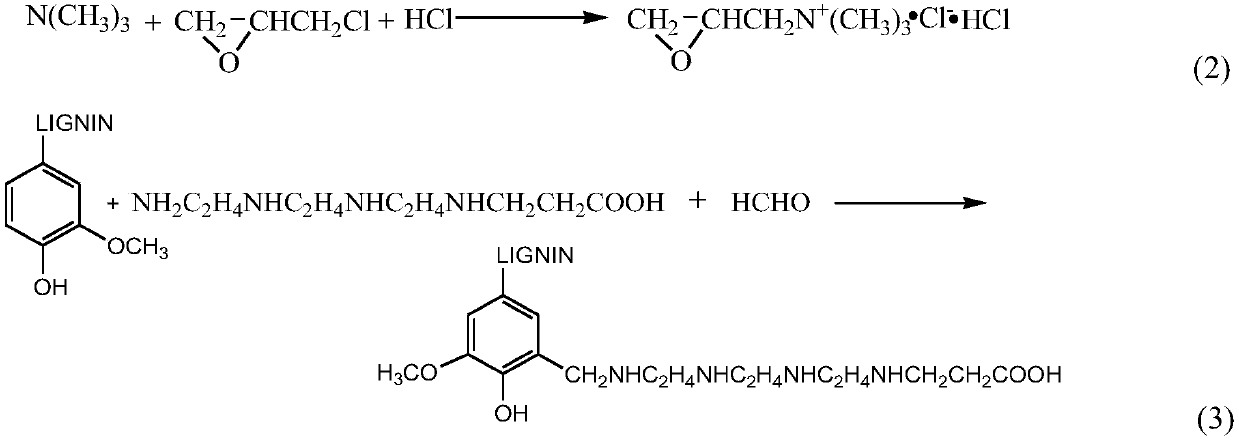A lignin polyamine cationic asphalt emulsifier and its preparation method and application
An asphalt emulsifier, cationic technology, applied in building components, building insulation materials, buildings, etc., can solve the problems of high requirements for production and experimental equipment, high cost of emulsifier raw materials, cumbersome preparation steps, etc., to achieve low production costs and increase Emulsifying performance, the effect of simple process
- Summary
- Abstract
- Description
- Claims
- Application Information
AI Technical Summary
Problems solved by technology
Method used
Image
Examples
Embodiment 1
[0048] (1) Preparation of lignin polyamine cationic asphalt emulsifier:
[0049] 1) Add 146.2 g of triethylenetetramine into the reactor, then dropwise add 72.1 g of acrylic acid, stir and react at 45° C. for 1 h, and obtain reaction intermediate I.
[0050] 2) Add 193.1g of 33% (mass fraction) trimethylamine aqueous solution to another reactor, gradually add 131.2g of 30% industrial hydrochloric acid, then gradually add 97.1g of epichlorohydrin, stir and react at 45°C for 2h, and obtain the reaction intermediate II.
[0051] 3) In another reactor, 283.0 g of lignin was dissolved in 649.6 g of 10.7% (mass fraction) sodium hydroxide aqueous solution, mixed and stirred for reaction to obtain reaction intermediate III.
[0052] 4) Add reaction intermediate I to reaction intermediate III, then gradually add 92.5 g of 37% (mass fraction) formaldehyde, and react at 70°C for 3 hours to obtain reaction intermediate IV;
[0053] 5) Gradually add the reaction intermediate II to the re...
Embodiment 2
[0064] (1) Preparation of lignin polyamine cationic asphalt emulsifier:
[0065] 1) Add 146.2 g of triethylenetetramine into the reactor, then dropwise add 72.1 g of acrylic acid, stir and react at 45° C. for 1 h, and obtain reaction intermediate I.
[0066] 2) Add 109.1 g of triethylamine to another reactor, gradually add 131.2 g of 30% industrial hydrochloric acid, then gradually add 97.1 g of epichlorohydrin, stir and react at 45° C. for 2 h to obtain reaction intermediate II.
[0067] 3) In another reactor, 283.0 g of lignin was dissolved in 649.6 g of 10.7% (mass fraction) sodium hydroxide aqueous solution, mixed and stirred for reaction to obtain reaction intermediate III.
[0068] 4) Add reaction intermediate I to reaction intermediate III, then gradually add 92.5 g of 37% (mass fraction) formaldehyde, and react at 60°C for 4 hours to obtain reaction intermediate IV;
[0069] 5) Gradually add the reaction intermediate II to the reaction intermediate IV, and react at 80...
Embodiment 3
[0079] (1) Preparation of lignin polyamine cationic asphalt emulsifier:
[0080] 1) Add 146.2g of triethylenetetramine into the reactor, then dropwise add 72.1g of acrylic acid, stir and react at 45°C for 1h, and obtain reaction intermediate I;
[0081] 2) Add 189.6g 85% (mass fraction) triethanolamine aqueous solution to another reactor, gradually add 131.2g 30% industrial hydrochloric acid, then gradually add 97.1g epichlorohydrin, stir and react at 45°C for 2h, and obtain the reaction medium Body II;
[0082] 3) In another reactor, 283.0g lignin was dissolved in 649.6g 10.7% (mass fraction) sodium hydroxide aqueous solution, mixed and stirred for reaction to obtain reaction intermediate III;
[0083] 4) Add reaction intermediate I to reaction intermediate III, then gradually add 92.5 g of 37% (mass fraction) formaldehyde, and react at 80°C for 2 hours to obtain reaction intermediate IV;
[0084] 5) Gradually add the reaction intermediate II to the reaction intermediate IV, ...
PUM
 Login to View More
Login to View More Abstract
Description
Claims
Application Information
 Login to View More
Login to View More - R&D
- Intellectual Property
- Life Sciences
- Materials
- Tech Scout
- Unparalleled Data Quality
- Higher Quality Content
- 60% Fewer Hallucinations
Browse by: Latest US Patents, China's latest patents, Technical Efficacy Thesaurus, Application Domain, Technology Topic, Popular Technical Reports.
© 2025 PatSnap. All rights reserved.Legal|Privacy policy|Modern Slavery Act Transparency Statement|Sitemap|About US| Contact US: help@patsnap.com



